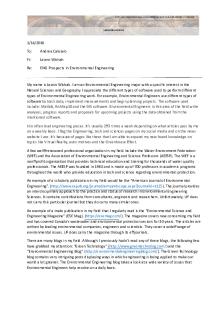Memo 1 MGMT1101 PDF

| Title | Memo 1 MGMT1101 |
|---|---|
| Course | Global Business Environment |
| Institution | University of New South Wales |
| Pages | 4 |
| File Size | 100.5 KB |
| File Type | |
| Total Downloads | 41 |
| Total Views | 143 |
Summary
MGMT1101 - Memo Assignment- Received a Distinction grade...
Description
Memorandum EBOS Healthcare Date: 25 February 2019
TO: Chief Executive Officer, EBOS Healthcare FROM: Senior Analyst, EBOS Healthcare SUBJECT: Proposed expansion to China
I recommend that we consider China, instead of the UK, as the more lucrative market for our innovative medical products. The major drivers of this suggestion are China’s economic growth, ageing population and increased government expenditure across healthcare industries. These indicators highlight the great potential for our firm to achieve a strong competitive advantage in the new market. I would further recommend we commence our strategy by directly exporting our products, allowing EBOS Healthcare to effectively establish itself as a trusted and reliable medical product brand in China.
At the meeting we discussed potentially entering one of two major global markets, China or the UK, as part of our global expansion strategy. After assessing China’s economic, demographic and political indicators, I would recommend entering the Chinese market over the UK. China has experienced favourable economic growth, with its 2017 GDP increasing by 6.9% compared to the UK’s steadier rate of 1.8% (WorldBank 2017). As such, China’s positioning as an emerging global economy has prompted a growing medical sector, in contrast to the UK where the sector is at its mature phase (IbisWorld 2018).
!
1
China’s demographics further support our entry into the market with continued population growth and an ageing population. It is projected that by 2020, China’s population will reach 1.4 billion, of which 248 million would be aged 60 years or over (Austrade 2016). Notably, China’s ageing population has underpinned the growth of medical products, with the medical device manufacturing industry forecasted to generate $18.5 billion in 2018, up 9.7% from 2017 (IbisWorld 2019). With the equivalent industry growth in the UK being only 3.6%, this reinforces my recommendation to enter China (IbisWorld 2018).
Additionally, the Chinese Government has reacted to its ageing population by significantly increasing expenditure within the healthcare industry. Specifically, the increased demand for medical products has been spurred by the greater purchasing power of hospitals and improvements in living standards, which are key aspects of China’s 13th 5-year plan (China Business Review 2017). Furthermore, the implementation of the China-Australia Free Trade Agreement has been paramount in creating opportunities for Australian firms, like ours, to contribute to the transformation of the Chinese health system (Qi & Zhang 2018). Comparatively, political factors affecting the UK, notably Brexit, add uncertainty to our potential entry, primarily regarding regulatory changes.
It would further be beneficial to enter the Chinese market through direct exporting. This would enable our firm to control all aspects of the market entry strategy without the involvement of an intermediary. This includes flexibility in creating and adjusting marketing activities to adapt to the Chinese market and receiving direct customer feedback. This would strengthen our efforts to establish EBOS Healthcare as a trusted, innovative medical brand in China. However, this entry mode features limitations, as it exposes our firm to more financial and market risk than indirectly exporting to an intermediary.
!
2
If this initial launch is successful in meeting profitability and shareholder expectations, I would recommend directly investing in China through subsidiaries and expanding our manufacturing facilities in the long-run. This would reduce importing costs and improve the efficiency of our distribution channels in China and the broader Asia market.
!
3
References Australian Trade and Investment Commission (Austrade) 2016, The Health and Aged Care Industry in China.
IbisWorld 2019, Medical Device Manufacturing Industry in China, viewed 19 February 2019,
IbisWorld 2018, Medical & Dental Instrument Manufacturing – UK Market Research Report, viewed 23 February 2019,
Qi, C & Zhang, JX 2018, ‘The economic impacts of the China-Australia Free Trade Agreement - A general equilibrium analysis’, China Economic Review (1043951X), vol. 47, pp. 1–11.
‘The Pulse of China’s Healthcare’ 2017, China Business Review, pp. 1.
The World Bank 2017, GDP Growth, viewed 22 February 2019,
!
4...
Similar Free PDFs

Memo 1 MGMT1101
- 4 Pages

Memo 1 - Memo 1 Assignment
- 2 Pages

MGMT1101 Detailed Notes
- 120 Pages

Memo - Memo
- 2 Pages

Project 1 - Vulnerability Memo
- 3 Pages

Task 1 Memo Report
- 2 Pages

Memo - Business Memo Assignment
- 2 Pages

Co-Sponser Memo 1
- 1 Pages

Memo-1 Technical Writing
- 3 Pages

Test 1 Memo
- 4 Pages

Memo - Memo for stocks
- 2 Pages

PAC113F Test 1 Memo 2011
- 5 Pages

244556089 Legal Memo 1 - cases
- 5 Pages
Popular Institutions
- Tinajero National High School - Annex
- Politeknik Caltex Riau
- Yokohama City University
- SGT University
- University of Al-Qadisiyah
- Divine Word College of Vigan
- Techniek College Rotterdam
- Universidade de Santiago
- Universiti Teknologi MARA Cawangan Johor Kampus Pasir Gudang
- Poltekkes Kemenkes Yogyakarta
- Baguio City National High School
- Colegio san marcos
- preparatoria uno
- Centro de Bachillerato Tecnológico Industrial y de Servicios No. 107
- Dalian Maritime University
- Quang Trung Secondary School
- Colegio Tecnológico en Informática
- Corporación Regional de Educación Superior
- Grupo CEDVA
- Dar Al Uloom University
- Centro de Estudios Preuniversitarios de la Universidad Nacional de Ingeniería
- 上智大学
- Aakash International School, Nuna Majara
- San Felipe Neri Catholic School
- Kang Chiao International School - New Taipei City
- Misamis Occidental National High School
- Institución Educativa Escuela Normal Juan Ladrilleros
- Kolehiyo ng Pantukan
- Batanes State College
- Instituto Continental
- Sekolah Menengah Kejuruan Kesehatan Kaltara (Tarakan)
- Colegio de La Inmaculada Concepcion - Cebu


